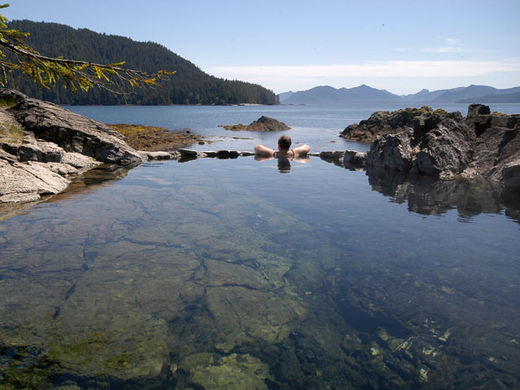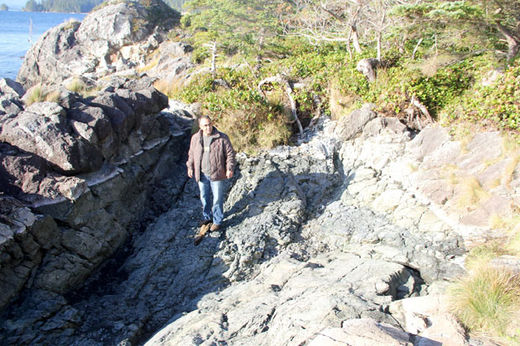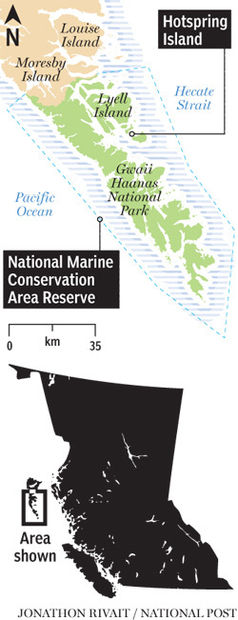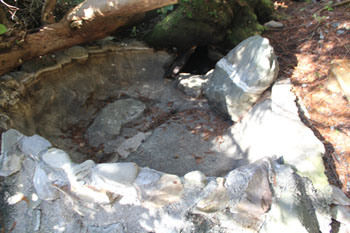
"It's a very culturally significant site - even today Haida people would go down to take advantage of healing properties of the springs," said Ernie Gladstone, a field unit superintendent for Gwaii Haanas National Park, of which Hot Spring Island is a part.
Earlier this week, scattered reports began drifting in that the familiar cloud of steam over the island (known as Gandll K'in Gwaayaay in the Haida language) had disappeared.
A Parks Canada inspection party set out to investigate and stepped ashore to find that the island's three main hot spring pools, which once bubbled with water as warm as 77 Celsius, were bone dry. "Not even a small puddle," said Mr. Gladstone.
Surrounding rocks, once warm to the touch, were cold.

Francis Poole, a copper prospector who became the islands' first white resident in 1862, later described the spring as "miraculous." After being told that springs were a "cure for all diseases," Poole advised his blacksmith, who had fallen ill with rheumatic fever to take a canoe to the sacred island.
A few days later, the blacksmith "reappeared ... not only fully restored in bodily health, but quite altered in a moral sense also," wrote Poole in an 1872 account of his time on the islands.
The area surrounding the hot springs is largely uninhabited, although it is near SGang Gwaay llnagaay, a Haida village of 300 that was abandoned in the 1880s following a devastating smallpox epidemic.
On Tuesday, local lodge owner Tassilo Goetz Hanisch became one of the first to notice that the heated waters were gone.
In books and travel blogs, kayakers, sailors and other visitors reported basking in the soothing water while occasionally spotting humpback whales in adjacent Juan Perez Sound.
Even passing commercial fishermen were known to slip ashore for a dip in the pools, although, like any visitor, they would first have to call ahead for permission from the Haida Watchmen, teams of volunteers that monitor cultural sites throughout Gwaii Haanas.
Striking just off the western edge of Haida Gwaii on Saturday, the quake has since been confirmed as the second-strongest ever recorded in Canada.
Coming in at 7.7 on the Richter scale, the tremor was much more powerful than the 7.0 earthquake that levelled much of Haiti in 2010 - yet the island's largely wood structures were able to ride out the shaking with almost no structural damage.
In coastal communities, residents anticipating a tsunami immediately set out for high ground, although Haida Gwaii beaches were hit by waves no larger than 43 centimetres.
It is not known what shut off the water flow, although it may have been one of the hundreds of aftershocks that rattled the islands well into the week, one of which struck less than one kilometre from the site.
In recent decades, the remote springs have become one of the area's most treasured tourist attractions. Only 12 visitors would be allowed into the pools at a time to maintain an "intimate experience," said Mr. Gladstone.
In books and travel blogs, kayakers, sailors and other visitors reported basking in the soothing water while occasionally spotting humpback whales in adjacent Juan Perez Sound.
Even passing commercial fishermen were known to slip ashore for a dip in the pools, although, like any visitor, they would first have to call ahead for permission from the Haida Watchmen, teams of volunteers that monitor cultural sites throughout Gwaii Haanas.
Striking just off the western edge of Haida Gwaii on Saturday, the quake has since been confirmed as the second-strongest ever recorded in Canada.
Coming in at 7.7 on the Richter scale, the tremor was much more powerful than the 7.0 earthquake that levelled much of Haiti in 2010 - yet the island's largely wood structures were able to ride out the shaking with almost no structural damage.
In coastal communities, residents anticipating a tsunami immediately set out for high ground, although Haida Gwaii beaches were hit by waves no larger than 43 centimetres.
It is not known what shut off the water flow, although it may have been one of the hundreds of aftershocks that rattled the islands well into the week, one of which struck less than one kilometre from the site.
"We don't know if it's going to come back. We certainly can hope," Brent Ward, an earth sciences professor at Simon Fraser University, told Postmedia.





Warning to the Christian and Non Muslim world!
We (Muslims) are inviting you to stop oppression on the Muslims. Don't you see the condition of your country? You are under the grate dissatisfaction of Allah for tormenting the Muslims of the whole world. As a result, different kinds of chaos and confusion, unnatural deaths and severe economic recessions including natural disasters like flash floods, snowfalls, tornados, wild fires and earthquakes of unusual magnitude are occurring in your country. You shall have more and more troubles! No way out! We invite you, refrain yourself from all those, Do Tawbah (repent) and convert to Muslims! Still time is there.
Courtesy
Tahjib-Tamuddun Department
Rajarbag Shareef, Dhaka-1217
BANGLADESH
[Link][Link]